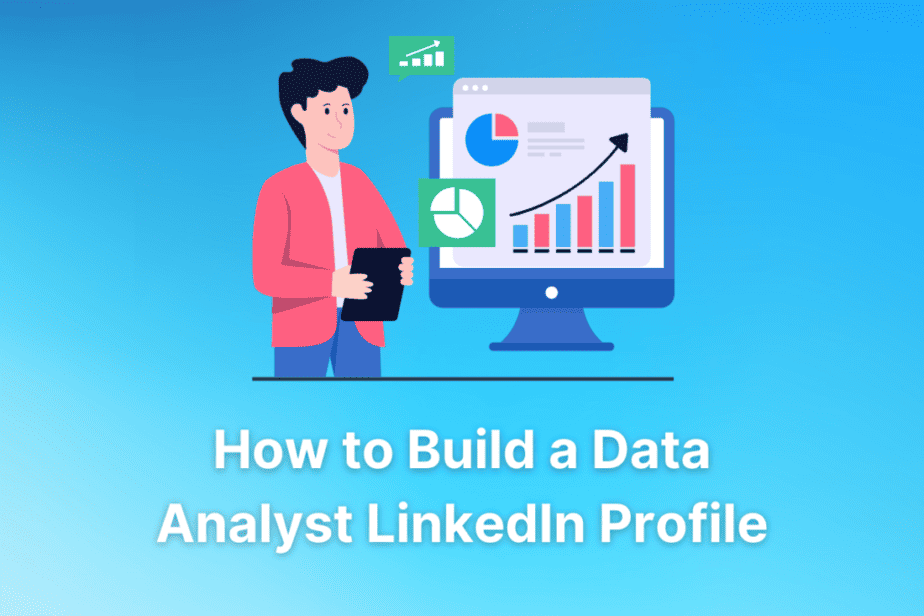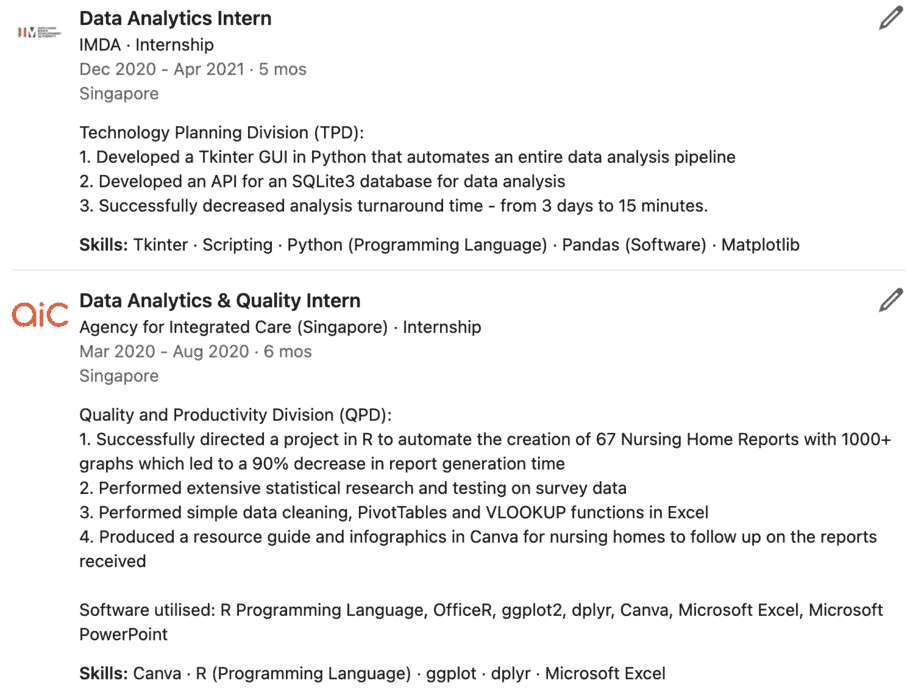How to Build a Data Analyst LinkedIn Profile
We’re reader-supported; we may earn a commission from links in this article.
Your LinkedIn profile is as important as your resume, especially in data analytics.
This might shock you, but 77% of recruiters utilize LinkedIn to find new candidates!
That’s why aspiring data analysts such as yourselves must have a LinkedIn profile that’s up-to-date and engaging at all times.
Don’t know how to build a robust LinkedIn profile for data analytics? This article will serve as a step-by-step guide for you!
Read on for more information.

How to Build a Good Data Analyst Linkedin Profile?
Before I dive into how to build one, you can check out my LinkedIn profile for reference.
With that, let’s begin!
1. Use a Professional Photo

Your profile photo is one of the first things that people will see when they visit your profile, so it’s important to use a professional-looking headshot.
Avoid using photos that are too casual or unprofessional, such as selfies and, worse: photos taken at parties.
It doesn’t take too much to get a professional shot; you can get your family member or friend to take a picture of you with a consistent background. Make sure you dress appropriately.
For guys, please at least wear a collared shirt (if you’re only taking a headshot). For the ladies, wear a professional-looking blouse.
2. Optimize Your Headline
Your headline is the second thing that people will see after your photo, so it’s important to make sure that it’s optimized.
Your headline should be a brief summary of your professional identity and should include keywords that describe your skills and experience.
Keywords you don’t want to miss:
- Data Analytics
- Programming
- Data Visualization
- SQL, Python, R, Tableau, Power BI
- Any other libraries and packages in Python and R you know well
- Machine learning algorithms
- Data Science
For example, you could use a headline such as “Data Analyst with 5 Years of Experience in the Retail Industry.”
If you don’t have experience, you can list your education, the skills you’ve obtained as a data analyst, and some notable projects you’ve completed.
You might want to tailor this portion to suit the requirements of a particular job description.
This exercise also helps you pick up new skills. I suggest you look at the job descriptions of the jobs you want to apply to and develop the required data analytics skills.
That is if you don’t know how to use Tableau or Power BI, go learn those from online courses!
This portion isn’t nearly as important because employers are usually more concerned about the next portion: your skills and experience.
3. Summarize Your Skills and Experience
In your summary, you should provide a brief overview of your skills and experience.
This is your opportunity to really sell yourself, so make sure to highlight your most relevant qualifications.
Use specific examples and data points to illustrate your skills and experience.
Write concisely and with bullet points to list the details of your experience. Employers won’t have too much time to scan through your profile.
I want you to try to put the results you’ve achieved into numbers.
Attracting bosses’ attention is all a numbers game. Why?
That’s because they are all about their KPIs; it’s what helps your bosses keep their jobs too.
Here are some examples:
- “Directed the reduction of 75% of data processing time for routine reports”
- “Initiated a pilot project that achieved 95% accuracy in myopia detection algorithm in school children”
My best tip for writing up your experience section is to begin your sentence with a verb that demonstrates initiative.
Use words like: ‘directed’, ‘initiated’, and ‘oversaw’ instead of ‘did’, ‘completed’, and ‘finished’.
Can you already tell the difference in how compelling the words are? 🙂
Even though you did the same work, using the right words can make you sound more confident and have more initiative.
To give you some ideas of what you can write, here’s my work experience on LinkedIn as a data analyst:

Here’s an example of showcasing my two internship experiences:

4. Highlight Your Projects
In the “Experience” section of your profile, be sure to highlight any projects that you’ve worked on that are relevant to the data analyst role.
For each project, include a brief description of your responsibilities and the results that you achieved. Again, be sure to use specific examples and data points to illustrate your work on the project.
For example, while I was doing my internship at a healthcare agency in Singapore, here’s what I wrote:
“Successfully directed a project in R to automate the creation of 67 Nursing Home Reports with 1000+ graphs which led to a 90% decrease in report generation time”
Notice how I combined the use of numbers and powerful words and highlighted the project I did?
Bosses want to see that you have the initiative to handle projects that they can entrust you with. By also including powerful statistics (numbers) in your write-up, your project becomes very compelling.
Additionally, you’ll want to make full use of the “Projects” portion to highlight your ability to create data visualizations. I recommend using Tableau Public, Rpubs, Rshiny, and Streamlit web applications to showcase your online portfolio.
As for me, as I applied some of my data analytics knowledge in my blog research process, I made sure I linked my blog post that I used Tableau dashboards.
These will help demonstrate how you can turn raw data into actionable insights that can drive business value.
5. List Your Education and Training
If you have relevant education and training in data analysis or related fields, list it in your profile’s “Education” section.
For each program that you list, include information about the school, the program, and any relevant coursework or training that you completed related to data analytics, data science, or machine learning.
Many employers look out for university graduates to fill their roles, but I know of some employers who look beyond traditional education certificates like degrees.
If you don’t already have small courses and certifications in data science or data analytics, you should start taking some and include them here!
6. Join Relevant Groups
There are many LinkedIn groups for data analysts, data scientists, and other professionals in the field, such as Data Science Central and KDnuggets.
Joining these groups can help you connect with other data analysts and stay up-to-date on industry news and trends.
To find relevant groups, search for keywords such as “data analyst” in LinkedIn’s search bar. You’ll be able to find many interest groups that talk about data analytics.
This can be a good way to build your network in the data industry.
7. Follow Relevant Companies
Another way to stay up-to-date on industry news is to follow relevant companies on LinkedIn.
Many companies post updates about their products, services, and hiring needs on their LinkedIn pages.
Search for keywords such as “data analytics” in LinkedIn’s search bar to find relevant companies.
By following data analytics companies, you can stay informed and stay connected with the data analytics industry.
This can help you get an idea of the priorities in a particular company, which will help with the job searching and job fit process.
8. Get Recommendations and Endorsements
Recommendations are a great way to show potential employers that you have proven yourself as a data analyst.
But of course, if you haven’t had any experience as an actual data analyst, make sure you get some of these from your previous employers to build your credibility.
Ask your colleagues, supervisors, or managers for recommendations on your profile.
If possible, ask them to specifically include your contributions to your company in artificial intelligence, creating data visualizations, or if you made any larger impact on their data analytics efforts.
9. Connect with Other Data Analysts
One of the best ways to grow your network is to connect with other data analysts on LinkedIn.
You can find other data analysts by searching for keywords such as “data analyst”, “big data”, or “data science”.
Once you find someone who looks interesting, send them a connection request and include a personal message letting them know why you’d like to connect with them.
I’d suggest first getting familiar with those data analysts that stay near your area. It might even give you an opportunity to meet up to network and share your technical expertise.
What is a Data Analyst LinkedIn Profile?
A data analyst LinkedIn profile is a LinkedIn profile that is specifically tailored to apply for a role in data analytics.
The profile should demonstrate knowledge in turning data into actionable insights, demonstrate technical expertise, and list all achievements and experience.
Reasons to Build a Standout Data Analyst LinkedIn Profile
1. Potential Employers Will Look at Your LinkedIn Profile
Your LinkedIn profile is one of the first places potential employers will look when they’re considering you for a data analyst position.
This is especially so if you first saw a data analyst job that you want on LinkedIn. Chances are high that the hiring manager is using LinkedIn and may look at your profile.
Hiring managers also may look through your LinkedIn profile during data analyst interviews. (this happened to me!)
2. Strong LinkedIn Profiles Help You Stand Out
2. A strong LinkedIn profile will help you stand out from the competition and make a good impression on potential employers.
Many choose to ignore their LinkedIn profiles, especially when they’re too busy with their jobs. Not to worry, if you’re here, it means that you’re on the right track.
3. LinkedIn Profiles Help You Build Meaningful Connections With Data Analysts
3. A good data analyst LinkedIn portfolio will help you develop connections with other data analysts and managers in the data industry over time.
With these connections, it can be a good way to build your network, which are backdoor entrances to potential jobs that they are looking to fill.
My Tips for Building a LinkedIn Profile for Data Analysts
- Work slowly over time: Update your LinkedIn profile gradually, not all at once! Trying to get it to be perfect so quickly can be tiring.
- Make full use of the featured section: Pin any notable links or images related to your analytics work.
- If you’re a student, build up your “volunteering” section: Many first internships are obtained due to a good attitude and aptitude demonstrated in volunteering opportunities.
Data Analyst LinkedIn Profiles Examples
Now let’s learn from other LinkedIn Users on how they stack their profiles for business analyst roles, data analyst roles, and management consultant roles in data analytics.
- Vivian Liu’s LinkedIn Profile looks simple yet contains all the elements that attract employers. Many other profiles are filled with too many words, but Vivian lists only the important items in her profile.
- Mingming Li’s LinkedIn profile is super comprehensive and compelling! He has his experience listed out clearly and well. His projects and publications at the end of the profile help him stand out.
- Chris Ramondelli has built up his data analytics experience over time and listed them very clearly in bullet points on his profile. He includes his education, volunteering, and awards. He also lists his projects under his experience portion.
- William Zimmerman’s profile ticks off all the good things on my list: a professional photo, a solid experience profile with concise info, education, certifications, volunteering opportunities, skills, recommendations, and publications.
- Look at my LinkedIn profile, which I used to land my first entry-level data analyst job without any relevant degree. I practice all that I preach in this article!
Final Thoughts
Remember, building a solid LinkedIn profile for a data analyst role helps you build an undeniable online presence that helps you stand out from other candidates.
Data analytics is a role that’s highly based on visualizations and the ability to create unique solutions using code, enabling actionable insights. And it’s the LinkedIn profile that you can showcase all these.
Now that you know what makes a good LinkedIn profile, I wish you all the best in your career, whether that be as a data analyst or a data scientist!
Thanks for reading! 🙂

Justin Chia
Justin is the author of Justjooz and is a data analyst and AI expert. He is also a Nanyang Technological University (NTU) alumni, majoring in Biological Sciences.
He regularly posts AI and analytics content on LinkedIn, and writes a weekly newsletter, The Juicer, on AI, analytics, tech, and personal development.
To unwind, Justin enjoys gaming and reading.



